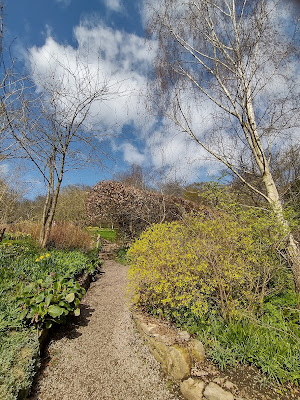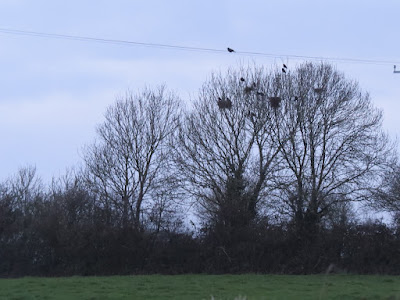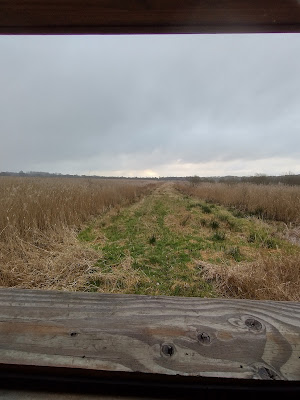It was Mrs Wessex-Reiver's birthday on Monday. Fear of reprisals prevents my mentioning a lady's age, save to say it was not a special one - but a special day unfolded. For a change I'm going to do this as an image and caption blog, just to increase the spice of my mid-life. The request was for a spiritually uplifting birthday, and, given the weather was perfect, where better than Glastonbury, Somerset.
First stop the Abbey Tea Rooms run by a sister of an ex work colleague of mine. We like it here, more Miss Marple tearoom than uber cool all chrome and light wood coffee experience. Sadly arriving at 11.31 hrs we were too late for the all day breakfast - a most acceptable cheese toastie each filled the void. I know how to go wild on a birthday. Consumed, there followed a ten minute walk to the Chalice Well nestling beneath the Tor.

The Chalice Well is one of the many 'Holy Wells' dotted around the country. The actual date of this Well is not certain, but it is thought to be at least the 12th Century, though some accounts place Joseph of Arimathea here not long after Jesus's death, where legend has it on the Tor itself Joseph struck a hawthorn staff into the soil which grew as the famous Glastonbury Thorn which flowers twice a year, Christmas and Easter. Since the 18th Century there had been a bathing pool where pilgrims can wash and bathe to gain health and meditative vigour from the flowing waters. Today was no exception, though I am told it was chilly.

Sometimes called the 'Blood Well’ due to the iron rich water staining the rocks, the well constantly flows at a rate of 25,000 gallons per day and at a constant year round temperature of 11 degrees centigrade. Once the Well formed at the foot-slopes of Glastonbury Tor. Today, while of course it hasn't moved physically, the Well is surrounded by a calming sanctuary garden, which in late March was perfect due to the amazing display of spring bulbs.
A nice ammonite feature on the path.
Since my last visit over ten years ago the meadow area, newly created then, has become a sunny area to sit and relax and listen to the birdsong.
While taking in the views of St Michaels Tower higher up the hill - more of that later.
The Well itself is now capped by an ornate cover, which I remember being newly installed on my last visit.
Two more views of the garden, it really was a lovely day. Chiffchaffs were calling, a raven flew in circles overhead, various other birds called, it felt like spring had finally arrived.
I even saw my first butterfly of the year, sadly unidentified as it flew behind the above hedge as soon as I'd noticed it. The Well water eventually enters a pool on the lower slopes before disappearing out of sight and eventually onto the Somerset Levels.
This crab apple was just perfect - in a few days it's blossom will dazzle and delight
Up the Tor then - the beginning of the path of which begins next to the Chalice Well. The entire Tor site has been owned and managed by the National Trust since 1933, and on our visit two Rangers were cleaning the signs and generally giving it a thorough spring clean. As they had the Land Rover with them I asked them that if I offered 50p would they drive me to the top. They declined, and as I had no more change to further bribe them, there was nothing for it other than to begin climbing the 301 steps. One, two....
There are some newly planted crab apple trees in the first field, a perfect circle. I asked why they're here and I was told it was simply a circular feature that it is hoped will bring joy to the visitors as the aim is for the trees to all flower at the same time. It'll be good to see these when mature.
Half way and the Tower is coming into view.
Looking back on Glastonbury itself, and the crab apple circle mid ground.
Handily there's a bench half way up - time to stand, or sit, and stare
Nearly there. Surprisingly the Tower only seems to be the same height as Mrs Wessex-Reiver. It looks much taller on the television.
Oh yes, a trick of the camera then, it's quite tall, though how tall I'm not sure. I've tried to find this out after our visit but I can only discover the tower, once part of a church before it was demolished during the Dissolution of the Monasteries period, stands on the top of the Tor, itself 518 feet above sea level.
Selfies, well you have to don't you....
View towards the south-south-west out of the door opening
And the view looking east from the other direction. We believe the ley line which straddles the Tor passes through the Tower, through these doors. I need to do more reading around this.
I can imagine this area will be packed in summer, thankfully on the day we visited only a dozen or so people had made it to the top. It was a perfect day to be up there, we could see for miles in every direction. I chatted to a couple of people on the top. One couple wanted to know where Admiral Hood's Monument was. I showed them a tiny column on the horizon to the south on the hill above Compton Dundon. Another couple visiting from Norfolk wanted to know where the Glastonbury Festival took place. I pointed to an area of green fields to the south east - "sort of over there", I said. I should be a tour guide.

All too soon it was time to descend the Tor, on what was my first even climb up there. I've lived nearby for thirty years and in those thirty years had never made it up the Tor. It's an old adage if one lives near to a feature or landmark, one always plans to go there - tomorrow. Well today I did it and surprised myself by romping up like a mountain goat. The steps helped but I enjoyed that walk without getting too breathless at all.
Back in the town we returned to the Abbey Tea Rooms, where I was forced to consume a chocolate sundae to celebrate Mrs W-R's birthday. She had a cup of tea and a Fentiman's
References
Chalice Well https://www.chalicewell.org.uk/
Admiral Hood Monument https://en.wikipedia.org/wiki/Admiral_Hood_Monument
St Michael's Tower https://www.nationalchurchestrust.org/church/st-michaels-tower-glastonbury










































